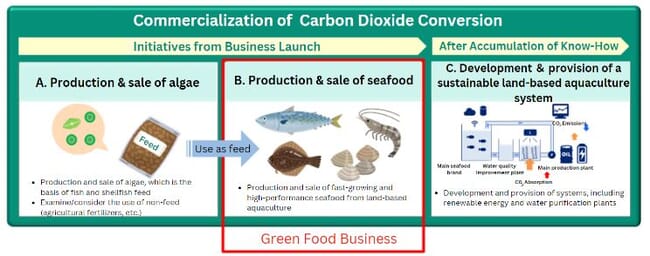
Beginning in Japan, NTT says that its goal is to create a replicable system that not only helps improve food security worldwide, but does so in a more efficient, more sustainable way.
The operations will be overseen by a brand new NTT Corporation subsidiary, NTT Green & Food, and will be divided into three processes:
1. Production and sale of algae
Algae use carbon dioxide through photosynthesis while they grow. By utilising NTT technologies including algae breeding technology – mass cultivation technology that adjusts to achieve the optimal temperature, humidity, nutrients and light intensity for algae production – the company says that it is possible to engineer the algae to store more carbon dioxide in their bodies than usual, while also activating photosynthesis and increasing the growth rate of the plants.
Algae, which contain DHA and EPA, are used as food for fish and shellfish, as well as an agricultural fertiliser, due to their high nutritional value. NTT Green & Food says that it will initially provide algae to aquaculture operators and farmers facing soaring feed and fertiliser costs due to recent price surges in raw materials.
2. Production and sale of seafood
By utilising the algae developed in Process A as a food fish source, NTT Green & Food aims to increase the growth rate for Regional Fish. In addition, by utilising breeding-improvement technology in land-based aquaculture facilities, NTT Green & Food can reduce the impact of natural disasters, parasites and the risk of infectious diseases on production. The seafood produced from this project will be provided to distributors, wholesalers and processors.
3. Development and provision of a sustainable land-based aquaculture system
Finally, the company aims to develop a holistic, land-based aquaculture system to produce the consumables outlined in processes A and B. This system will consist of: a facility that produces fish and shellfish; a facility that produces the algae to feed them; and a facility that purifies fish and shellfish excrement. Full commercialisation would include sales of the system to third parties through NTT Corporation and its operating companies.
NTT Green & Food says that it aims to achieve revenues of about $70 million in about five years, and over $200 million in around a decade.


